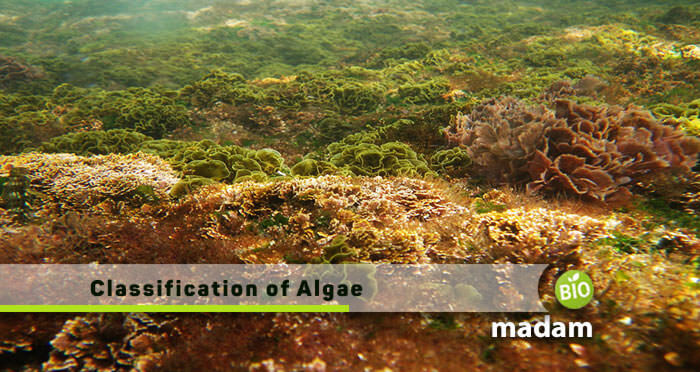Along with other numerous living bodies existing on the plant, a significant one is an alga. Algae are aquatic eukaryotes having chlorophyll that carry out oxygen-producing photosynthesis. Scientists named it “Alga,” meaning “aquatic plants,” but these species differ greatly from plants. Phycology or Algology is the detailed study of algae. They are distinguished from plants in lacking a well-organized vascular conducting system and acquiring a simple reproductive structure. However, a few plants, like mosses, have some common features with algae.
Main Algae Properties
These organisms have long ago been discovered and are still on the path. In all this duration, experts have gathered the following primary characteristics an alga holds:
- Specific cell wall and morphology
- Numerous flagella with the location of their insertion in motile cells.
- Morphology of the cells and body (thallus)
- Chlorophyll molecules and accessory pigments
- Distinct reproductive structures
- Proper habitat
- Life history patterns
How are Algae Classified?

Different scientists studied algae in detail and finally came up with a proper classification list based on special characteristics. They are generally distributed into six classes, based on the cellular properties belonging to two different kingdoms (Plantae and Protista). Let’s quickly flip through the list before heading towards the details of all.
| Division | Common Name | Kingdom |
|---|---|---|
| Chlorophyta | Green Algae | Protista |
| Euglenophyta | Euglenoid Flagellates | Protista |
| Chrysophyta | Diatoms | Protista |
| Phaeophyta | Brown Algae | Protista |
| Rhodophyta | Red Algae | Protista |
| Pyrrophyta | Dinoflagellates | Protista |
Molecular classification systems have placed some of the classical algae with:
- Plants (Green Algae)
- As a separate lineage (Red Algae)
- With the Stramenopiles (Golden-Brown & Yellow-Green Algae, Brown Algae & Diatoms)
- With the alveolates (Dinoflagellates)
- And others with some protozoa (Euglenoids)
The classification, alveolates and stramenopiles, recently came to the view, based on rRNA comparisons and ultrastructural studies.
Alveolates: have mitochondria with tubular cristae and subsurface alveoli or sacs. Examples of alveolates include dinoflagellates, ciliate protozoa, and apicomplexan protozoa.
Stramenopiles: contain mitochondria with tubular cristae and hollow hairs that give rise to a small number of fine hairs. The Photosynthetic forms of stramenopiles often have chlorophylls a and c, palinid protozoa, oomycetes, diatoms, brown algae or phaeophytes, etc.
Short Summary of Algal Classification
| Division | No. of Species | Chlorophylls | Phycobilins | Carotenoids | Thylakoids per sac |
|---|---|---|---|---|---|
| Chlorophyta | 7500 | a, b | – | β-carotene, ±α-carotene, xanthophylls | 3-6 |
| Euglenophyta | 700 | a, b | – | β-carotene, xanthophylls, ±τ-carotene | 3 |
| Chrysophyta | 6000 | a, c1/c2, rarely d | – | α-, ß-, ε-carotene, fucoxanthin, xanthophylls | 3 |
| Phaeophyta | 1500 | a, c | – | β-carotene, fucoxanthin, xanthophylls | 3 |
| Rhodophyta | 3900 | a, d (rare) | C-phycocyanin, Allophycocyanin, Phycoerythrin | Xanthophylls, (β-carotene, zeaxanthin, ±α-carotene) | 1 |
| Pyrrophyta | 1100 | a, c1, c2 | – | β-carotene, fucoxanthin, peridinin, dinoxanthin | 3 |
Details of All Algae Types
It was essential to display a quick and brief algae table with its classifications. Now that you have had an idea of all its types, let’s step towards explaining each.
Green Algae – Chlorophyta
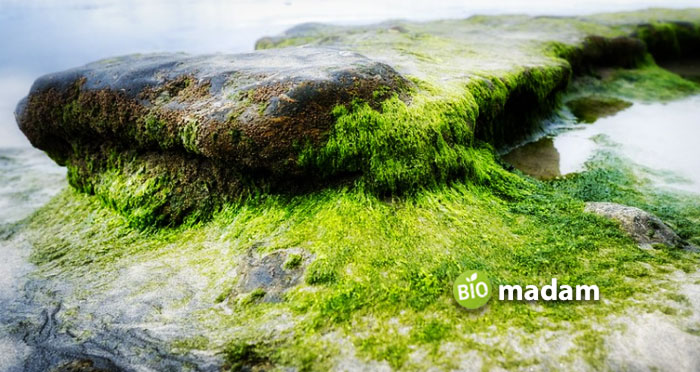
It is a heterogeneous group of photoautotrophic protoctists (a phylum) comprised of green algae living in freshwater, saltwater, soil, and other organisms. Green algae have a wide variety of shapes, sizes, and habitats of an ecosystem. It is highly diverse in morphology, ranging from microscopic unicellular entities to macroscopic multicellular algae. It also exhibits various body forms, ranging from unicellular to colonial, filamentous, membranous, sheet-like, and tubular types.
Sub-Classes of Chlorophyta
It further has nine sub-classes as per the Hoek, Mann and Jahns system, which are as follow:
- Chlorodendrophyceae (46 species)
- Chlorophyceae (3046 species)
- Ulvophyceae (1610 species)
- Trebouxiophyceae (672 species)
Pigments: The predominant pigment, chlorophyll a and b, in the Chlorophyta comes with specific carotenoids. According to the molecular classification, these are associated with the plants’ kingdom and have mitochondria with lamellar cristae.
Reproduction: Green algae reproduce both sexually and asexually. Here, the Chlamydomonas reproduce asexually through zoospores by cell division and involve the formation of flagellated and non-flagellated spores.
The Function of Contractile Vacuole: The two vacuoles present at the base of flagella function as osmoregulatory organelles that continuously remove water.
Example: Chlamydomonas, a representative unicellular green alga, have two flagella of equal length at the anterior end by which they move rapidly in water. Each cell contains a nucleus, large chloroplast, conspicuous pyrenoid, and a stigma (eyespot). Stigma helps in the phototactic responses.
Euglenoids – Euglenophyta
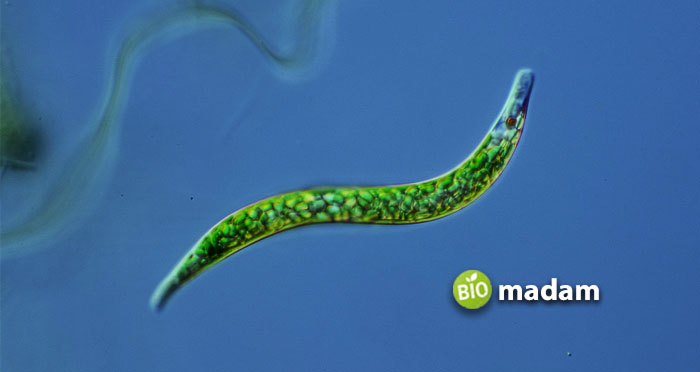
Euglenophyta occurs in fresh, brackish, and marine waters and on moist soils; they often form water blooms in ponds and cattle water tanks. They have 40 genera and 1000 species. Euglenophyta have chlorophyll a and b in their chloroplasts, just like the Chlorophyta.
Producer & Heterotroph: Euglenophyta is the primary producer and heterotrophs of both bacteria and other eukaryotes.
Flagella: Some euglenids form a symbiotic relation with metazoans. They have 3 to 4 flagella per cell. In molecular classification schemes, euglenoids are associated with the amoeboflagellates (flagellated protozoa) and kinetoplastids because all members have rRNA sequences and mitochondria with discoid cristae at some stage in their life cycle.
Contractile Vacuole: The stigma is located near an anterior reservoir. Contractile vacuoles inside the cell regulate the osmotic pressure within the organism by continuously collecting water from the cell and empties it into the reservoir.
Primary Storage Product: The paramylon (a polysaccharide composed of β-1, 3 linked glucose molecules) is unique to euglenoids and is deposited as granules in the cytoplasm. Besides, this algae class has different shapes, such as ovoid, spindle-shaped, or flattened single cells (unicells), of various transverse shapes depending on the genus or species.
Example: Euglena is the representative genus of Euglenophyta. A typical Euglena cell is elongated and bounded by a plasma membrane; it contains a pellicle structure composed of articulated proteinaceous strips lying side by side. This pellicle enables the turning and flexing of the cell.
Diatoms – Chrysophyta
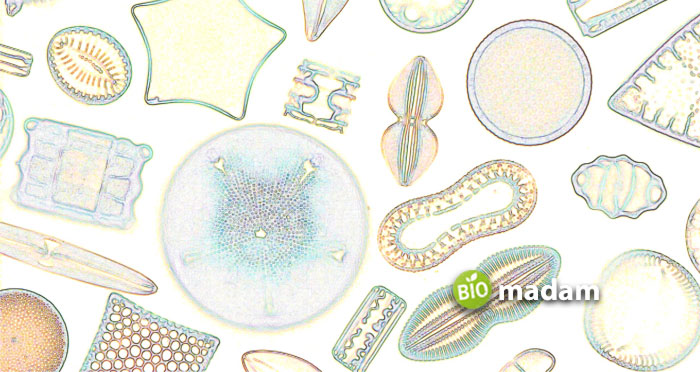
Chrysophyta is a common component of the plankton in oligotrophic lakes, thus found in freshwater, although a few species and subspecies are found in brackish or marine waters. They may be the primary source of food for zooplankton.
Type of Species: Most Chrysophyta are unicellular or colonial, but there are also some multicellular species.
Nature of Existence: They are not true autotrophs because some species become facultatively heterotrophic in the absence of adequate light or the presence of plentiful dissolved food.
Photosynthetic Pigments: these are usually chlorophylls a and c1/c2 and the carotenoid fucoxanthin. The cells have a golden-brown color when fucoxanthin is the dominant pigment.
Storage Product: The storage polysaccharide in chrysophytes is chrysolaminarin (a polysaccharide storage product composed principally of β-1, 3 linked glucose residues, dissolved in special vacuoles).
Genera & Species: Chrysophyta has 200 genera and 1000 species.
Reproduction: Diatoms or green-brown algae generally have asexual reproduction, but they’re occasionally sexual as well.
Further Sub-division: These are further sub-divided into three major classes:
- Golden-brown algae
- Yellow-green algae
- Diatoms
Brown Algae – Phaeophyta
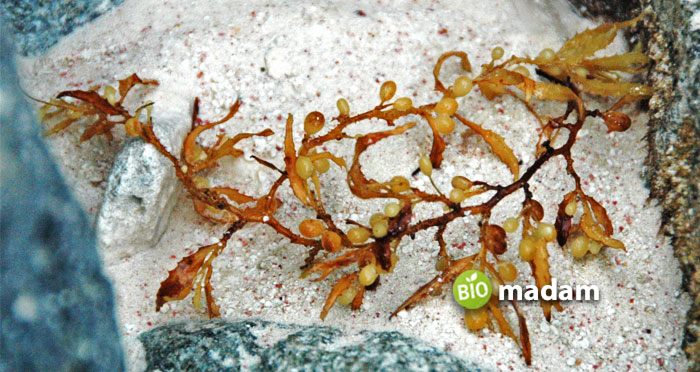
The Phaeophyta arises from the Greek word “phaeo,” which means brown. Brown algae are the most complex form of multicellular algae mostly present in the sea. Phaeophyta includes no single-celled species; the simplest brown algae consist of small openly branched filaments; the larger, more advanced ones have a complex arrangement.
Special Pigments: Phaeophyta contains the brown pigment fucoxanthin, which gives them a brown color. The other accessory pigments are chlorophylls a and c, carotene, and violaxanthin.
Storage Product: Laminarin is the storage product of Phaeophyta.
Typical Algae Size: The size of Phaeophyta ranges from a microscopic length to several meters.
Phaeophyta consists of nine orders of 240 genera and over 1,500 species. So, the order of Phaeophyta is following.
- Ectocarpales, for example, Ectocarpus.
- Tilopteridales, for example, Ptilopteris.
- Cutleriales, for example, Cutlria.
- Sporochnales, for example, Sporochnus.
- Desmarestiales, for example, Desmarestia.
- Laminariales, for example, Laminaria.
- Sphacelariales, for example, Sphacelaria.
- Dictyotales, for example, Dictyota.
- Fucales, for example, Sargassum.
Red Algae – Rhodophyta
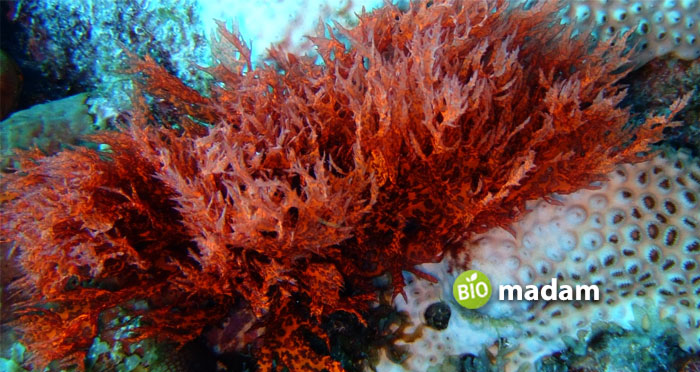
The Rhodophyta arises from the Greek word “rhodon,” meaning rose, mostly including seaweeds. Mainly Rhodophyta species are filamentous and multicellular, but few reds are unicellular. These consist of about 831 genera and over 5,250 species.
Storage Product: They store carbohydrates as Floridian starch (composed of β-1, 4 and β-1, 6 linked glucose residues).
Photosynthetic Pigments: Rhodophyta contains the red pigment phycoerythrin along with blue pigment phycocyanin. These pigments help in the survival of this at depths of 100 m or more.
Cell Wall: The cell walls include a rigid inner part composed of microfibrils and a mucilaginous matrix.
Inner Matrix: It comprises sulfated polymers of galactose (source of galactan) called agar, funori, porphyrin, and carrageenan. These four polymers give the red algae their flexible, slippery texture. Porphyridium is a particular source of sulfated polymers of galactose.
Function: Agar is used extensively in the laboratory as a culture medium component for cultivating bacteria, etc.
Dinoflagellates – Pyrrophyta
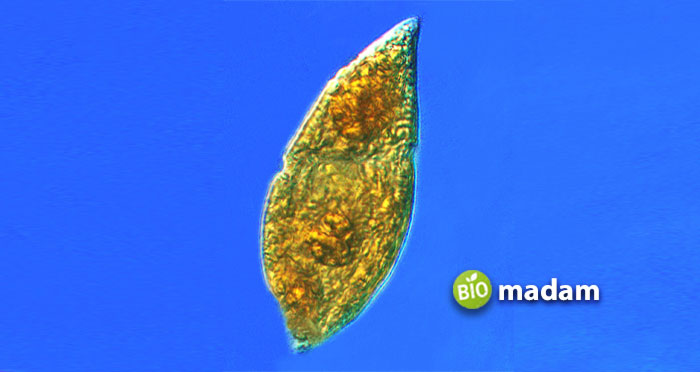
Most dinoflagellates are marine, but some live in freshwater. They further have chlorophylls a and c and carotenoids and xanthophylls. As a result, these species usually have a yellowish-green to brown color. Furthermore, the cells’ mitochondria have tubular cristae.
An Outlook!
Algae are pretty important for the survival of animals and human beings as they function to provide maximum oxygen. They are widely distributed all around the world in numerous sizes, shapes, and colors. Many algae are found in lake water, freshwater, or marine, but their presence is also observed on the rocks, different organisms’ bodies, soils, etc. Last but not least, these living entities are a great source of providing nutrition like carbs, fats, and proteins with trace elements like magnesium, calcium, potassium, manganese, etc.

Jeannie has achieved her Master’s degree in science and technology and is further pursuing a Ph.D. She desires to provide you the validated knowledge about science, technology, and the environment through writing articles.

